Construction Labels and Signage
03
February,
2023
3 MINUTE READ

According to OSHA, more than 6 million people work at roughly 250,000 construction sites throughout the United States on any given day. These employees routinely face numerous hazards, including heights, electrocution, falling objects, and more.
It's important for employers to warn workers about these hazards and encourage safe practices at all times. One easy, efficient way to improve safety is to post construction labels and signage around the job site.
Here's a look at what OSHA recommends for safety signage, various types of signs and labels, and how to keep workers safe.
Construction Site Hazards
First things first: You should know which hazards are present on your jobsite so you can help workers avoid, mitigate, or otherwise plan for those hazards. Here's a quick breakdown of common construction site hazards so you can better prepare potentially life-saving visual communication.
- Falls: Falls accounted for an astounding 40% of all construction industry deaths in 2014. Signs may advise workers to wear fall protection, stay clear of exposed areas at height, and more.
- Electrocutions: Visual communication can warn workers of power lines, provide instruction for operating electric tools, and more.
- Caught-in/between: This occurs when workers are caught in machinery or between moving objects. Visual communication can warn employees to keep back, point out alternate routes around the job site, and provide information about when to fill holes.
- PPE: Disaster can strike when employees don't wear hard hats, gloves, safety vests, or other valuable pieces of equipment. Safety signs can alert users to the need for PPE, explain where on a job site it's required, and show where PPE is located.
OSHA and ANSI Standards
OSHA's standard for construction signs, signals, and barricades-29 CFR 1926.200-explains the agency's requirements for safety signage. It explains that signs should be visible whenever work is performed; it also includes requirements for "Danger" signs, "Caution" signs, and other important visual communication around a job site.
Broadly speaking, OSHA suggests that construction labels and signage should conform to the ANSI Z535 standard. The standard dictates all aspects of sign design, including:
- Sign and label colors
- Signal words (such as "Danger," "Warning," and "Caution")
- Letter style and size
- Sign and label placement
ANSI updates the standard every five years, most recently in 2017, and employers should abide by the new standard whenever possible. Updating old ANSI signs can minimize confusion.
Here are the types of visual communication singled out in OSHA's standard for construction signs, signals, and barricades -and how they should look.
"Danger" Signs and Labels
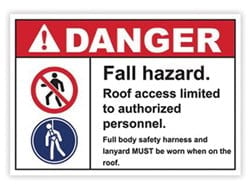
Use "Danger" signs when immediate hazards exist and have the following characteristics:
- The upper panel should have a red background
- A black outline should border the sign
- The lower panel should have a white background; any additional symbols or wording should be in black
OSHA also allows for "Danger" signs that follow the ANSI Z53.1-1968 standard (which lacks the triangular safety symbol, but includes the word "DANGER" set against a red oval); however, this standard is not up to date, and employers should conform to the current ANSI Z535 standard whenever possible.
"Warning" Signs and Labels
OSHA's standard for construction signs, signals, and barricades outlines requirements for "Danger" and "Caution" signs. However, the standard does not include a provision for "Warning" signs, typically used in general industry for hazards that may result in death or serious injury.
"Caution" Signs and Labels
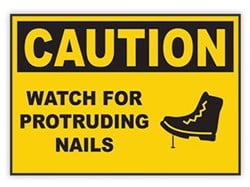
"Caution" signs should be used to warn about potential hazards and to warn against unsafe practices. They should feature the following characteristics:
- Signs should have a yellow background, with a black upper panel and border
- The word "Caution" should be in yellow lettering against the black panel
- The lower yellow panel should be reserved for additional symbols or words, both in black
OSHA allows for "Caution" signs that follow the ANSI Z53.1-1967 standard; however, this standard is outdated, and employers should conform to the current ANSI Z535 standard, whenever possible.
Exit Signs and Labels
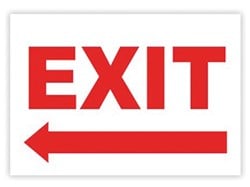
OSHA maintains in 29 CFR 1926.200(d) that "Exit" signs and labels should have the following attributes:
- The word "Exit" should be in legible red letters and 6" or taller
- The main lines of the letters in the word "Exit" must be at least 3/4" wide
- The sign must be printed on a white background
Safety Instruction Signs and Labels
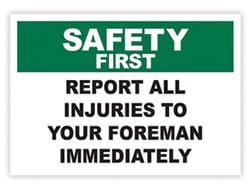
Safety instruction signs and labels typically communicate general instructions and suggestions for keeping the workplace safe. These signs might remind employees to use proper lifting techniques, encourage best practices around machinery with moving parts, and ask workers to put tools away when done.
OSHA, in 29 CFR 1926.200(e), outlines the following requirements for safety instruction signs and labels:
- Signs must be white, with a green upper panel
- White letters within the green upper panel should convey the sign's general message (e.g. "Safety First")
- Any additional wording should be printed in black letters on the white background
Directional Signs and Labels
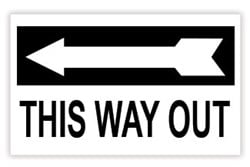
Directional signs are useful for helping employees find their way around a jobsite. OSHA, in 29 CFR 1926.200(f), lays out the following requirements for directional signs and labels:
- Signs must be white, with a black panel and white directional symbol
- Additional wording on the sign must be in black lettering on the white background
Construction Labels and Signage Resources from Duralabel
Duralabel free Best Practice Guide to OSHA Safety Signs covers best practices for labeling in accordance with OSHA and ANSI requirements and standards. The guide breaks down relevant requirements, provides an outline for how (and where) to post signs, and offers resources for getting started. Download it today.
RELATED RESOURCES

What is an OSHA 300 Log?and do I have to use one?
If your workplace has more than 10 employees at any time throughout the calendar year, and is non-exempt, ...
Read
OSHA 29 CFR 1926
Construction is a high hazard industry, with unique situations and hazards, and it employs more than six ...
Read
DOT Labels
49 CFR 172.400 specifies that Department of Transportation (DOT) Labels must be used for hazardous materials ...
Read.png)


